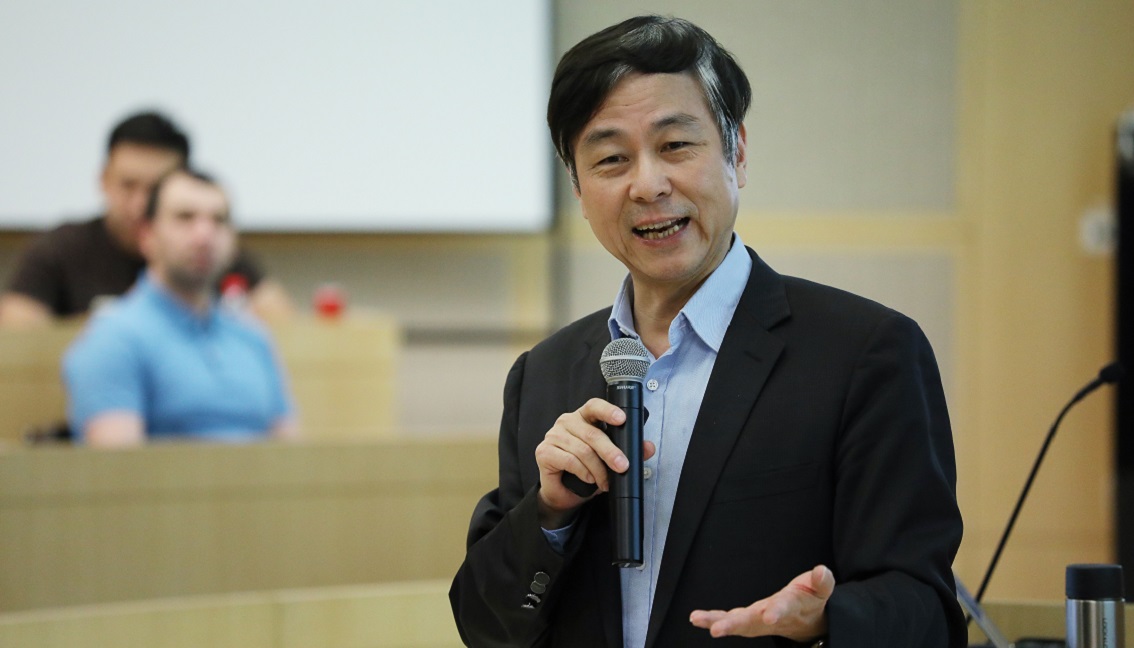Speakers Series
sidenav header backgroundOwnership Neutrality vs. Competitive Neutrality: SOE Issue in WTO Reform

What is Ownership Neutrality? What is Competitive Neutrality? How have these concepts evolved as implicit principles in the current WTO reform and affected the trade tensions between China and the United States? LU Feng, Chair Professor of Economics and Director of China Macroeconomic Research Center at National School of Development at Peking University, examines the involving issues as well as China's policy in this large context. On May 17, 2019, he delivered lecture on" Ownership Neutrality vs. Competitive Neutrality: SOE Issue in WTO Reform”. Prof. FU Jun, Academic Dean of the Institute of South-South hosted the event.
The concepts of the twin neutralities have generated a lot of interests in policy research circles. Prof. LU pointed out the recent policy debates in China concerning Competitive Neutrality and Ownership Neutrality. “China will accelerate internal reforms and is considering adopting the competitive neutrality principal”, said Prof. YI Gang, the governor of the people’s bank of China, while others said, “we also advocate ‘the ownership neutrality’… oppose against imposition of discriminative treatment on SOE through international rule making”. The dichotomy of the two neutralities provides a useful perspective to look at the issue of SOE provisions and market economy status at large in the context of the current WTO reform.
Competitive Neutrality means no business entity is an advantaged or disadvantaged solely because of its ownership, it is a policy framework dealing with the possible extra market advantage acquired by the SOE over their private counterparts due to special linkage with governments; while Ownership Neutrality is a term coined by a WTO law expert to avoid picking-up of specific firms such as SOEs in design and implementation of rules.
As Prof. LU introduced, the two neutralities are closely related to China’s participation in the global market. China’s WTO accession provides a noticeable case to explain the significance of ownership neutrality, as specific rules regarding SOEs have been established in several occasions as part of the negotiated terms for China’s accession.
Similarly, competitive neutrality is used by the U.S. in overhaul of its China Policy since 2011, as it believes that China’s development model is the so called “state capitalism” that should be checked and balanced by emphasizing the rule of competitive advantage. Promoted by the U.S. and its close allies, many bilateral and regional economic partnership agreements have included various provisions on SOE and competitive advantage.
However, the addition of clauses on SOEs and Competitive Neutrality in international trading rules is obviously at odds with the principle of Ownership Neutrality. Ownership Neutrality implicitly indicates that it may be not necessary to set up special rules on function of SOEs in the international trading rules; while Competitive Neutrality principle is based upon the assumption that there should be special rules regarding the way by which SOEs operate in a market economy.
Based on this historical background, Prof. LU then analyzed the growing pressure to modify WTO recently. The revision of WTO rules is mainly promoted by the rapid evolution of global economic environment and the need to further promote globalization. There are two driving forces behind the CN reform agenda in the context of evolving WTO reform. One is the underlying need to create a new generation of competition rule incorporating SOEs as an integral part of the international economic agreements for the 21 century open market economy. Another is the policy motivation of the U.S. & its allies to create new instruments in the arena of international rule as a check and balance for the so-called China’s “state capitalism” growth model.
In Prof. LU’s opinion, the Chinese position is justified understandable, China’s SOE as a whole are now much more viable in a more open and equal competitive environment. But the government needs to further strengthen the reform of SOEs for China’s growth in the long run and take into consideration the fact that the law making for competitive advantage principle and SOEs clause has been accepted by 60% of the global economy.
With the students' great interest aroused in this topic, one of them asked how China entered WTO despite the unfavorable condition in 2001. They also came up with questions concerning the impacts of US-China trade war and the concept of free trade market. Through the talk, the students learned not only the new development of the WTO reform, but also the importance to detect the changes in the global economy through the policies released by the governments and organizations and analyze the changes from a historical and global perspective.







